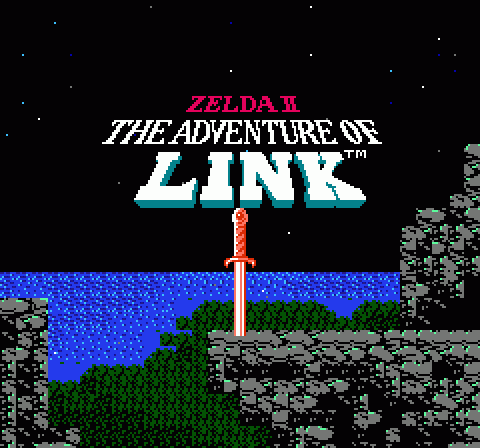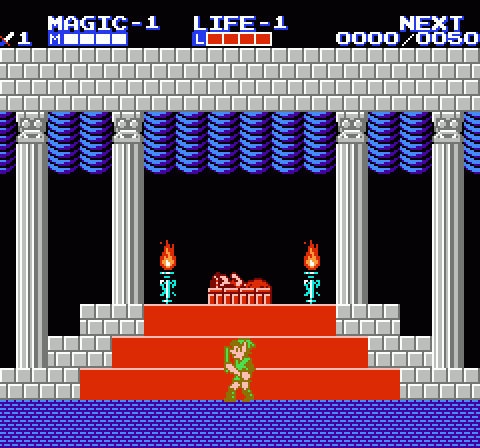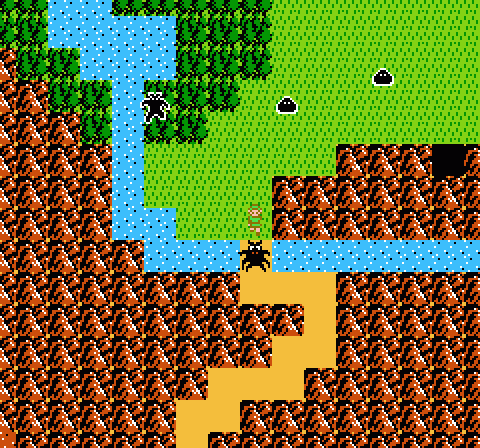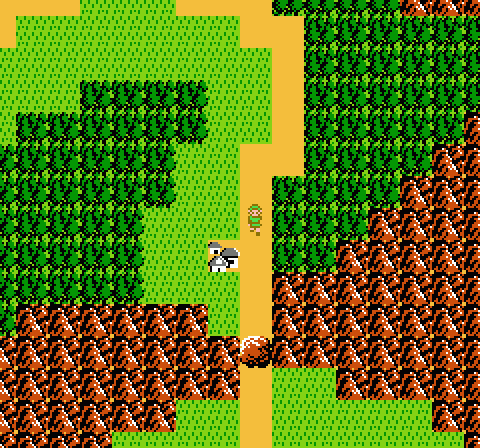Welcome to the beginning of the latest chapter of Anatomy of a Game. You can read more musings on The Legend of Zelda‘s design at the Anatomy of a Game landing page, and thoughts on the NES Castlevania trilogy are also available for digestion both online and in a self-published book.
And now, let’s dissect The Adventure of Link.

In designing The Legend of Zelda, Nintendo’s tiny team drew upon a number of existing video game conventions and concepts to create something new and unique. While you could see the family resemblance to well-established computer game genres like adventure genre and RPGs, Shigeru Miyamoto and company framed those elements in a format that drew more upon the quick-reflex action of arcade games. Zelda had a handful of direct antecedents, most notably Atari’s Adventure, Exidy’s Venture, and Namco’s Tower of Druaga; yet Nintendo’s far more detailed work combined these games’ vaguely RPG-inspired trappings with the greater depth afforded by the relatively more powerful NES hardware and the persistent data (a largely new feature for console games) capabilities of the Famicom Disk System.
With Zelda II: The Adventure of Link, Nintendo came at the problem from a different direction. Ever restless, the design team wasn’t content to simply rehash Zelda‘s design and mechanics. Video games still existed in a primal soup, waiting for definition and evolution, and this particular team wasn’t content to simply iterate when so many other concepts begged exploration. Unlike Super Mario Bros. 2, Zelda II wasn’t simply a harder remix of the previous game’s elements; on the contrary, that would have been redundant, given the way they build that kind of “sequel” right into the disk as the Second Quest. Still, Zelda II seems to have been designed to answer a similar fundamental question to that of its predecessor: “How do we combine role-playing and action elements?”
Where the two works differed was the prism through which its elements were refracted. The first Zelda took staid PC-based genres and made them more console-like. Zelda II, however, tackled influences closer to home: Budding console game genres. Equal parts action platformer (e.g. Super Mario Bros.) and console RPG (e.g. Dragon Quest, the original of which launched in Japan mere months after Zelda and had become a phenomenon by the time Zelda II rolled around a year and a half later), Zelda II more boldly combined these influences with brisk run-and-jump action and RPG staples like experience points and magic spells.

For fans familiar with the original, Zelda II presented quite the shock. It opens with Link in side view, standing directly in front of the slumbering princess Zelda. Gone is the top-down perspective and four-directional combat. Instead, Link gets about in a fashion instantly familiar to Japanese console gamers of 1987; if they owned anything for NES, it was probably Super Mario Bros. Or maybe Spelunker.
The Zelda players see at the outset, as explained in the manual, happens to be the O.G. Zelda from centuries before, a woman cursed to sleep eternally. Link, tasked with finding the third portion of the mystical Triforce (unaccounted for in the first game), sets out not to save Hyrule but to awaken Zelda. Then again, saving Hyrule is unavoidably in the cards to a certain degree, as bad guys roam the land hoping to kill Link and use his blood to feed the ashes of Ganon and fuel his resurrection (a bizarrely grim premise for a Nintendo title) and thus his re-conquest of the land.
Like its predecessor, Zelda II begins without preamble save a brief story scroll on the title screen. The player begins with Link dead center in the screen in a “safe” place and sets off with him. Comparing these opening seconds, one can already see material differences between Zelda and its sequel. The opening screen of Zelda presented players with no less than four choices for advancement (west, north, east, cave), the latter of which beckoned players to explore the scenery and discover the concepts of entering the underground and collecting equipment.
Zelda II lets you go left or right. Neither choice makes any actual difference — the outcome is the same either way as you end up in the exact same spot from either exit — and you have no other options for action. Zelda dozing on the platform may inspire you to jump and hit the attack button in an attempt to interact, but it ultimately amounts to nothing: Zelda is simply scenery here. Nothing of significance happens on this screen.
But let’s not jump to hasty conclusions. The less meaningful design of Zelda II‘s first screen doesn’t mean it’s overly simplified from its predecessor or somehow frivolous and without merit. That opening screen serves multiple purposes: It sets the stage for the story to come, introducing your ultimate goal and the slightly unconventional-for-its-time plot construction (you’re out to save a princess, as in so many games, but not from a villain’s clutches), gives you a brief glimpse of the action mode of the game, and provides a jumping-off point for the journey.

Once you step outside that first screen’s boundaries — and this time the game’s environments scroll rather than appearing as static screen-by-screen steps — you get a better sense of how greatly Zelda II has changed from the last adventure. The original Zelda‘s top-down action RPG mechanics appear to have been dropped into a centrifuge and spun out into their individual components, separating the experience into a pure action portion and an action-free exploration portion. The overworld now consists not of dozens of screens of action identical to the dungeon experience save the overall sense of openness and free-roaming but rather a zoomed-out view extremely similar to that of Dragon Quest. Link eventually gains a handful of abilities he can use here on the overworld, but those are limited and essential serve as keys to open paths forward. This viewpoint is strictly for traversal — for getting from point A to B. The meat of the game takes place in the side-scrolling sequences.
Link even faces random encounters on the overworld, just like Dragon Quest. Well, semi-random: In a feature more reminiscent of Ultima, monsters do appear as you explore, but contact with them doesn’t represent combat in and of itself. Instead, it sends you into a combat arena that plays out via the player’s core actions — in this case, attacking and jumping rather than Ultima‘s turn-based tactics. You can even get a sense of the enemies you’ll face based on the icon you contact. Weak enemies appear as Gels (in the U.S. version, anyway; they looked for all the world like little sperm cells in Japan) while tougher foes looks like Moblins. The exact mix of enemies that appear in a combat sequence vary based on your location within the world and the nature of the land in which you enter combat with them (forests present different combat scenarios than deserts or plains, for example).

Dungeons, towns, obstacles, and other points of interest appear on the overworld as Link-sized icons beckoning for exploration — not unlike the caves and ruins of the original Zelda. The two games ultimately share a common spirit of exploration and conquest through battle, but they present it in greatly different ways. Its next few sequels would go back to the original top-down format, but that doesn’t mean Zelda II‘s style and concepts lack merit. On the contrary, much of its design would go on to inform the 3D games beginning with Ocarina of Time. Much like Simon’s Quest, Zelda II feels like something of an aberration; yet, in context, it simply shows the designers getting ahead of themselves, and ahead of what tech and game design of the time could handle. This may be the black sheep of the family, but it’s an important part of the Zelda lineage despite its flaws.
Zelda II. Such a great game. I may be biased a bit, seeing as how it was my first NES game _ever_, but there it is.
Really looking forward to this series, Jeremy! It’s off to a great start.
the map of this game was mindblowing to me as a child, and probably the first time i realized that game worlds could be expansive and amazing around every corner.
Nice to have another Zelda Anatomy, I’ll enjoy playing through it again. When I owned once the cartridge I wasn’t able to get past the area before reaching the final palace.
I understood then that you needed better skills and not only your Link maxed out in order to confront the odds and finishing the game.
Was this another design approach?
With age comes wisdom and perspective when playing again through this games.
I hated Zelda II, and actually didn’t like the original Zelda that much either. Jeremy’s Anatomy of the first one actually made me appreciate the game, so let’s see what he can do for this one.
I’m another one who played this game before the original Zelda. Although LttP became my favorite, I’d stack II up against I any day. I’m honestly not entirely sure whether I ever beat it, though.
I do like the “semi-random encounters” mechanic on the map, and it’s something I’ve considered incorporating into the game in my head that I may or may not ever get around to working on.
Oddly enough, I think this is one of those rare games that I used to really, really like and now I dislike it more each time I play through it. I admire a lot of the things it tries to pull off, but I just don’t find it to be a fun game to play through anymore. The temples all seem like boring generic boxes to me (like the mansions in Castlevania II) and I find the enemies within them to be really monotonous to fight against. It seems like most of the gameplay in the temples (at least early on) is walking through an empty, barren hallway while stabbing the same hopping guy in the face 300 times.
That said, another great article in this series. I’m looking forward to reading the rest and seeing how you break this game apart.
@Tato: You’re not wrong. The game really isn’t that fun. It’s repetitive and frustrating and difficult. If it came out now, it would be widely panned (as opposed to, say, Mega Man 2 or Super Mario Bros. 3, which would be beloved if they came out in 2013- just look at the generally positive reception Mega Man 9 got).
Still, there are a lot of interesting and important design decisions, so I think it’s a good candidate for an Anatomy of a Game series.
@Will
That’s just your opinion, and it’s slightly aggravating when people post speculations like that as fact based only on the fact that they don’t enjoy the game.
I’m really digging these Anatomy of a Game posts, and I’m especially excited to see this game dissected. I preferred the first Zelda, but my 12-year-old brain was a sucker for the sequel’s fresh but flawed take, and especially the sound design.
I remember the drudgery of grinding for experience, but I still loved it. RPG mechanics were new to me at the time. Gaining a level was an Accomplishment that was worth the grind.
Many things I’ve loved in the past have not withstood the test of time, so I’m eager to see Parish’s perspective on this one.
I love this game, and things like the save states in the newer Virtual Console releases really help negate a lot of the worst aspects of it. Seriously happy to see you’re doing this one as your next Anatomy series. =)
I just wish we had another Zelda game like this… or heck, use Kid Icarus instead. In the meantime, I need to get my hands on Adventure Time.
For all the differences that make this seen as the ‘not-Zelda’ of the series, I love this game.
This was a great read, really looking forward to the rest of your analysis. I love Zelda II as well and think it’s criminally underrated, especially among hardcore Zelda fans. I think I like it even moreso now than I did as a kid. This could just be me being contrary for the sake of being contrary, but I think it’s because it’s one of the few Zelda games I actually consider being quite difficult. Like the original, it has almost none of the hand-holding that plagues the series nowadays. I also love how huge Hyrule appears in this game, with several towns all loaded with people. It’s a far cry from the original where Hyrule seems like a wasteland peppered with a few hermits living in caves.